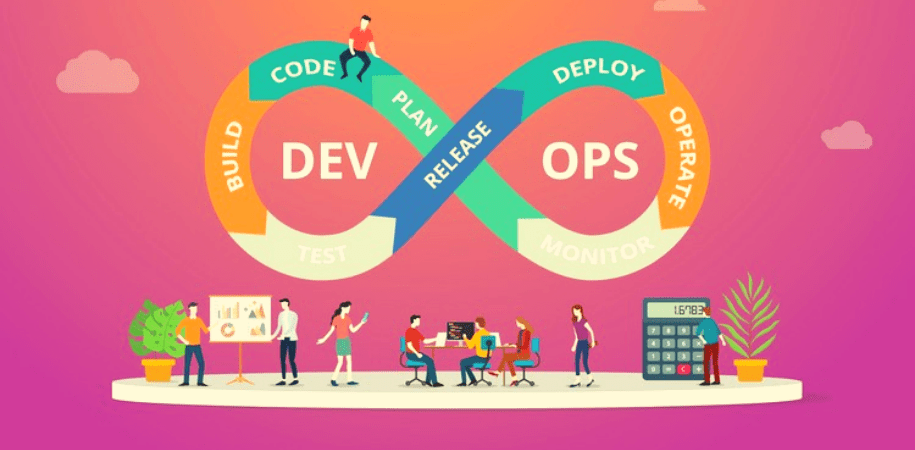DevOps, a key concept in the technical community. It is the intersection of software development and operations to ensure continuous integration (CI) and delivery (CD).
A DevOps Tool is an application that aids in the automation of the software development process.
DevOps is defined as follows in simple terms for those unfamiliar with the term: A set of processes in which software engineers and operations engineers collaborate.
They collaborate as a unified front throughout the software development cycle, from ideation to production support.
The development and service sides were thought to be separate entities with different responsibilities in a software cycle. However, due to this, many challenges were encountered, such as increased development time, low throughput, etc.
The primary motivators for DevOps are increased production time, improved communication, lower costs, and fewer deployment failures.
To leverage the power of DevOps, a company must manage five significant processes: communication, CI/CD, configuration management, security, and monitoring and alerting.
How are DevOps tools helpful?
DevOps tools focus on communication and collaboration among professionals. It helps in product management, software development, and operations.
DevOps tools also allow teams to automate most software development processes such as build, conflict management, dependency management, deployment, and so on, reducing manual labor.
What are the top 10 DevOps tools to learn DevOps for beginners?
1. Slack
Slack, which was launched in 2013, is still one of the top communication tools used by teams for effective project collaboration. This DevOps tool is used by technical organizations worldwide.
It helps to break down barriers and provide all team members with a clear understanding of the workflow.
Slack has an exciting feature that allows developers to collaborate using toolchains in the same environment to communicate with other maintenance and service members.
2. Jenkins
Jenkins, an open-source continuous integration server, automates the entire software project build cycle. The Pipeline feature, which allows developers to commit code to the repository, run test cases, and retrieves reports obtained after testing, is the tool’s USP.
This customizable tool provides instant feedback and will alert you if a specific sprint is causing a broken build or harming it. The majority of SDLC tasks and tools can get automated using Jenkins, allowing team members to increase their throughput.
3. Docker
Docker is a tool at the heart of containerization, gaining traction in the IT world. Docker enables secure application packaging, deployment, and execution regardless of the running environment.
Every application container contains the source code, supporting files, run time, system configuration files required for application execution.
The Docker Engine can get used for accessing containers, which can then execute applications in a remote environment. Organizations have been able to reduce infrastructure costs thanks to the app.
According to one report, two out of every three companies that tried this application adopted it within 30 days of using it.
4. Splunk
One of the primary concerns of any DevOps team is software security. As a result, the Splunk tool can be of great assistance to developers who want to build a secure infrastructure from the start of the SDLC.
Using the Splunk tool, you can collaborate in a centralized environment on an incident while also being aware of emerging security threats.
The tool also allows DevOps professionals to mitigate such risks in real-time by employing techniques such as file detonation, device quarantine, and so on.
5. Nagios
Nagios, like Splunk, is a monitoring tool that keeps track of your applications, servers, and overall business infrastructure.
The tool is handy for large organizations with many circuitry (routers, servers, switches, etc.) in the backend. It notifies users if a specific fault occurs on the backend or if any device fails. It also keeps a performance chart and monitors trends regularly to warn the user of any potential failures.
6. Vagrant
A vagrant is a tool that allows you to manage and work with virtual machines in a single workflow. Team members can use Vagrant to share software running environments and test applications more quickly without setting up configurations.
The tool ensures that the environment for a specific project remains consistent across every developer’s machine and can abandon the excuse of “runs on my system.”
7. Ansible
Ansible is the most famous DevOps tool. Ansible is one of the most basic yet powerful IT orchestration and configuration management tools on the market.
This tool is primarily used for pushing new changes into the existing system and configuring newly deployed machines. Lowering infrastructure costs and increasing replication speed of scalability are just two of the reasons why this is an absolute favorite among IT companies.
It is simple to use—you don’t even need a dedicated systems administrator capable of handling highly complex deployments. Furthermore, it is agentless and employs a simple syntax written in the YAML language. NASA uses ansible.
8. GitHub
GitHub, founded in the year 2000, is still one of the top DevOps tools for easy collaboration. Using this tool, developers can make rapid changes to the code, with notifications sent to other team members in real-time.
In the event of an error or a fallout, the tool’s branched history of changes allows for instant rollbacks to the previous version in seconds.
9. Sentry
Sentry, a tool used by companies such as Uber and Microsoft, is one of the best DevOps tools for detecting errors or bugs.
This free tool supports languages such as Ruby, IOS, JavaScript, and others, and it also includes SDKs that can be customized to support the majority of languages and frameworks.
The tool continuously scans lines of code throughout the system and sends notifications if it discovers an error or problem. Not only does it highlight the issue, but it also provides a list of possible solutions that can get implemented with a single click.
10. BitBucket
BitBucket, like GitHub, is a tool for managing project code throughout the software development cycle. While GitHub remains the most popular repository.
People are shifting to BitBucket due to its lower cost and the private repository feature (a feature only available in the paid variant of GitHub).
While the core functionality of BitBucket is similar to that of GitHub, features such as easy integration with Jira and Trello and built-in CI/CD functionality give this Atlassian tool an advantage.
Conclusion
You will find all the DevOps tools mentioned above being used in a web development company in UK and all over the world. DevOps can improve an organization’s software development and the delivery process and its software quality.

















Add Comment